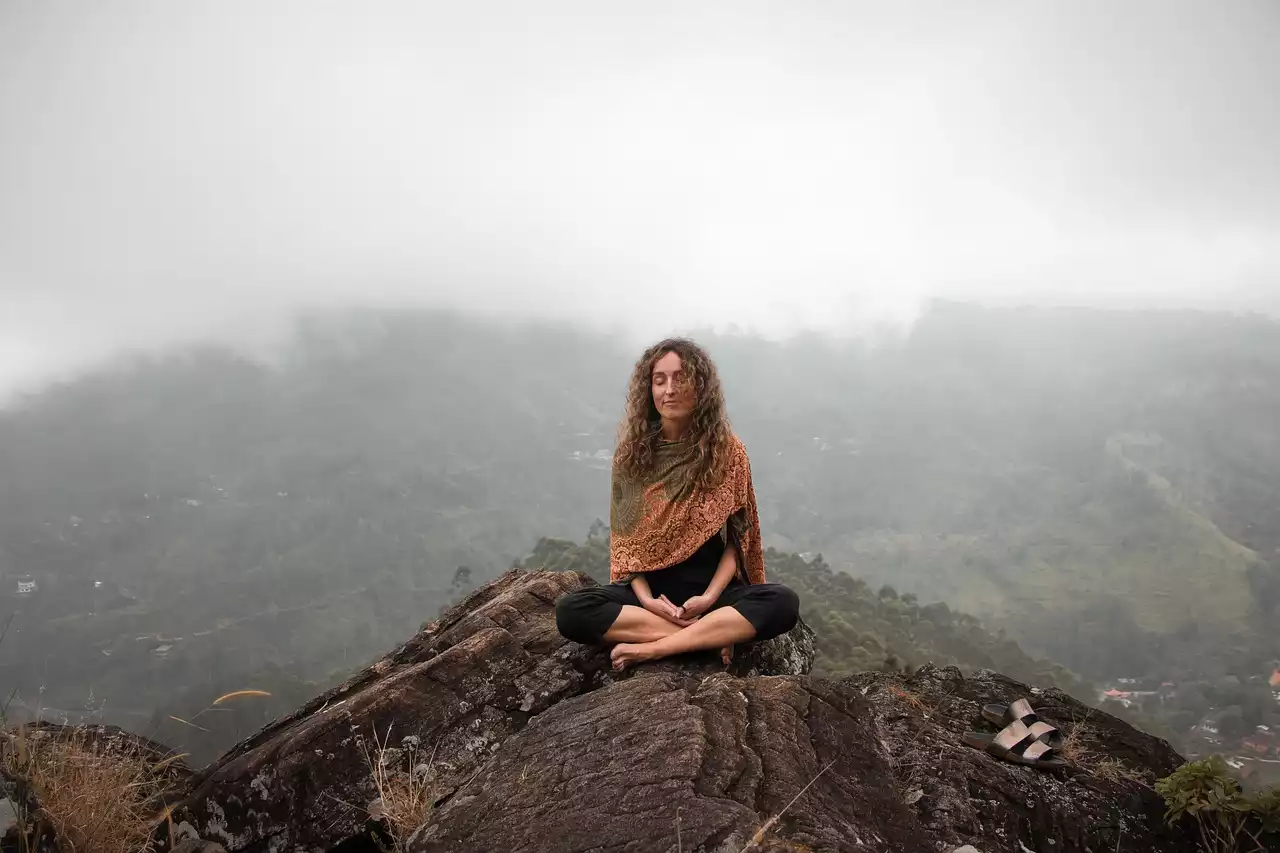1.Breathwork:
2. Mantra chanting:
3. Mudras:
4.Visualization:
1. Choose a quiet and comfortable space:
2. Set your intention:
3. Get into a comfortable posture:
4. Create a sacred space:
5. Warm-up exercises:
 Preparing for a Kundalini meditation session
Preparing for a Kundalini meditation session1. Choose a quiet and comfortable space:
2. Set your intention:
3. Get into a comfortable posture:
4. Create a sacred space:
5. Warm-up exercises:
1. Restlessness and wandering thoughts:
2. Physical discomfort:
3. Impatience and expectations:
4. Lack of motivation or consistency:
5. Overstimulation or overwhelming experiences:Exploring advanced Kundalini meditation practices
1. Kriyas:
2. Meditative practices:
3. Advanced breathwork:
4. Mantras and sacred sounds:
What is Kundalini meditation?
Kundalini meditation is a practice that aims to awaken the dormant energy that lies at the base of the spine, known as Kundalini energy. This energy is said to be coiled like a serpent, hence the name Kundalini, which means "coiled" in Sanskrit. The goal of Kundalini meditation is to unleash this dormant energy and allow it to rise through the different energy centers, or chakras, in the body. By doing so, practitioners can experience a profound transformation that encompasses physical, mental, and spiritual aspects of their being.
Kundalini meditation is deeply rooted in ancient Indian traditions, particularly in the practices of Yoga and Tantra. It has been practiced for thousands of years by yogis and spiritual seekers as a means to attain enlightenment and self-realization. In recent years, Kundalini meditation has gained popularity in the West, as more and more people are discovering its transformative power. It offers a unique approach to meditation, combining physical movements, breathwork, chanting, and meditation techniques to awaken and channel the Kundalini energy.
The philosophy behind Kundalini meditation is based on the belief that each individual has a divine energy within them, which, when awakened, can lead to spiritual growth and self-realization. This energy is thought to be the source of our vitality, creativity, and inner wisdom. Through the practice of Kundalini meditation, we can tap into this infinite source of energy and experience a profound shift in our consciousness.
Kundalini Awakening - (What is Kundalini?)
Understanding the concept of energy and chakras
To fully grasp the essence of Kundalini meditation, it's important to understand the concept of energy and the role of chakras in this practice. According to the ancient Indian tradition, the human body is comprised of seven main energy centers, or chakras, which are located along the spine. These chakras are believed to be interconnected and represent different aspects of our physical, emotional, and spiritual well-being.
The first chakra, known as the root chakra, is located at the base of the spine and is associated with our sense of stability, grounding, and survival instincts. The second chakra, called the sacral chakra, is located just below the navel and is associated with our creativity, sexuality, and emotions. Moving up the spine, we encounter the solar plexus chakra, which is linked to our personal power, confidence, and self-esteem. The heart chakra, located in the center of the chest, is associated with love, compassion, and emotional healing.
Continuing up the spine, we reach the throat chakra, which governs our communication, self-expression, and ability to speak our truth. The third eye chakra, located between the eyebrows, is associated with intuition, insight, and spiritual awareness. Finally, the crown chakra, situated at the top of the head, represents our connection to the divine and higher states of consciousness.
In Kundalini meditation, the aim is to awaken and balance these chakras, allowing the Kundalini energy to flow freely through them. This process leads to a harmonization of the body, mind, and spirit, and facilitates a deep sense of well-being, clarity, and spiritual awakening.
Benefits of Kundalini meditation
Kundalini meditation offers a wide range of benefits that can positively impact various aspects of our lives. Here are some of the key benefits of practicing Kundalini meditation:
1. Increased awareness and consciousness:
Kundalini meditation works to expand our awareness and consciousness by activating the dormant energy within us. As the Kundalini energy rises through the chakras, it clears blockages and opens up new pathways for self-discovery and spiritual growth.
2. Enhanced vitality and energy:
By awakening the Kundalini energy, practitioners often experience a surge of vitality and increased energy levels. This renewed energy can help combat feelings of fatigue, enhance productivity, and improve overall well-being.
3. Heightened creativity and intuition:
Kundalini meditation has been known to unleash one's creative potential and deepen their intuition. As the Kundalini energy flows freely through the chakras, it nourishes the creative and intuitive aspects of our being, leading to enhanced artistic expression and a greater sense of inner knowing.
4. Stress reduction and emotional healing:
Kundalini meditation techniques, such as breathwork and chanting, have been shown to reduce stress, anxiety, and depression. The deep relaxation and inner peace experienced during Kundalini meditation can facilitate emotional healing and provide a sense of balance and calmness in daily life.
5. Improved physical health:
Regular practice of Kundalini meditation can have a positive impact on physical health. The activation of the Kundalini energy can help balance the body's systems, strengthen the immune system, and promote overall well-being.
10 Min Kundalini Kriya For Awakening For Beginners | GUIDED KUNDALINI MEDITATION
If you're new to Kundalini meditation, it's important to start with simple techniques that will help you ease into the practice. Here are a few beginner-friendly Kundalini meditation techniques to get you started:
1.Breathwork:
Conscious breathing is an integral part of Kundalini meditation. Start by sitting in a comfortable position with your spine straight. Close your eyes and take a few deep, slow breaths, focusing on the sensation of the breath entering and leaving your body. As you become more comfortable, you can introduce specific breathwork techniques, such as the "Breath of Fire" or "Alternate Nostril Breathing," which are commonly used in Kundalini meditation.
2. Mantra chanting:
Chanting mantras is another powerful technique in Kundalini meditation. Mantras are sacred sounds or phrases that are repeated to focus the mind and create a meditative state. Start by choosing a mantra that resonates with you, such as "Om" or "Sat Nam," and repeat it silently or aloud during your meditation practice. Allow the vibrations of the mantra to permeate your being, creating a sense of harmony and connection.
3. Mudras:
Mudras are hand gestures that are used to channel and direct energy during meditation. They can help deepen your focus and enhance the overall experience of Kundalini meditation. One simple mudra to try is the "Gyan Mudra," where you touch the thumb and index finger together while keeping the other fingers extended. This mudra is believed to enhance wisdom and concentration.
4.Visualization:
Visualization is a powerful tool in Kundalini meditation. Close your eyes and visualize the rising of the Kundalini energy from the base of your spine, moving up through each chakra, and eventually reaching the crown of your head. Visualize each chakra as a vibrant and radiant energy center, and feel the energy expanding and illuminating your entire being.
Remember, consistency is key when it comes to Kundalini meditation. Set aside a dedicated time and space for your practice, and be patient with yourself as you explore and deepen your experience.
Preparing for a Kundalini meditation session
Before you begin your Kundalini meditation session, it's important to create a conducive environment that supports your practice. Here are a few tips to help you prepare:
1. Choose a quiet and comfortable space:
Find a space in your home where you can practice undisturbed. Make sure the space is clean, clutter-free, and free from distractions. You can enhance the ambiance by lighting candles, burning incense, or playing soft instrumental music.
2. Set your intention:
Before you start your meditation, take a moment to set an intention for your practice. This could be anything you wish to cultivate or manifest in your life, such as peace, clarity, or self-love. Allow this intention to guide your meditation and infuse it with meaning.
3. Get into a comfortable posture:
Find a comfortable seated position, either on the floor or on a cushion. Sit with your spine straight and your shoulders relaxed. You can choose to sit cross-legged, in a lotus position, or on a chair, whatever feels most comfortable for you.
4. Create a sacred space:
Consider creating a small altar or sacred space in front of you, where you can place meaningful objects or symbols that inspire you. This could include crystals, sacred texts, images of spiritual figures, or anything else that holds significance for you.
5. Warm-up exercises:
Kundalini meditation often incorporates physical movements and warm-up exercises to prepare the body for the energy awakening. Before you start your meditation, you can perform simple stretching exercises or yoga poses to loosen up your body and release any tension.
Remember, the most important aspect of preparation is to approach your meditation practice with an open mind and a willingness to explore and discover. Be present in each moment, and allow yourself to fully experience the transformative power of Kundalini meditation.
How to manage accidental Kundalini Awakening?
Like any meditation practice, Kundalini meditation may come with its own set of challenges. Here are some common challenges that practitioners may encounter and tips on how to overcome them:
1. Restlessness and wandering thoughts:
It's natural for the mind to wander during meditation, especially in the beginning. If you find yourself becoming restless or distracted, gently bring your focus back to your breath or the object of your meditation. Remind yourself that it's okay to have thoughts, but gently let them go and return to the present moment.
2. Physical discomfort:
Sitting in one position for an extended period can sometimes lead to physical discomfort or stiffness. If you experience discomfort, adjust your posture or try incorporating gentle movements into your practice, such as stretching or rotating your neck and shoulders. You can also use cushions or props to support your body and make yourself more comfortable.
3. Impatience and expectations:
Kundalini meditation is a journey that unfolds at its own pace. Avoid placing expectations on your practice or becoming impatient with the results. Instead, approach your meditation with curiosity and an open mind, allowing yourself to embrace each moment as it comes.
4. Lack of motivation or consistency:
It's common to face challenges in maintaining a regular meditation practice. To stay motivated, remind yourself of the benefits you have experienced so far and the positive impact meditation has on your overall well-being. Set achievable goals, start with shorter practice sessions, and gradually increase the duration as you build consistency.
5. Overstimulation or overwhelming experiences:
Kundalini meditation can sometimes lead to intense experiences or emotional releases. If you find yourself feeling overwhelmed, take a break or shorten your practice. It's important to honor your boundaries and listen to your body. If needed, seek guidance from an experienced teacher or mentor who can provide support and guidance.
Remember, the challenges you encounter in your Kundalini meditation practice are an opportunity for growth and self-discovery. Embrace them as part of your journey and approach them with compassion and patience.
Exploring advanced Kundalini meditation practices
The UnXplained: The Mystic Powers of Meditation (Season 3)
Once you have established a regular Kundalini meditation practice and feel comfortable with the basics, you may be ready to explore more advanced techniques. Here are a few advanced Kundalini meditation practices that you can delve into:
Kundalini Yoga: Complete Spinal Series
1. Kriyas:
Kundalini Kriyas are specific sets of exercises and movements designed to awaken and balance the energy centers in the body. They often involve dynamic movements, breathwork, and chanting. Explore different Kriyas under the guidance of an experienced teacher to deepen your practice and expand your energetic awareness.
2. Meditative practices:
As you progress in your Kundalini meditation journey, you can incorporate more focused and advanced meditation techniques. This may include practices such as "Third Eye Meditation," where you focus your attention on the space between your eyebrows, or "Crown Chakra Meditation," where you direct your awareness to the top of your head.
3. Advanced breathwork:
Kundalini meditation offers a wide range of breathwork techniques that can be explored as you advance in your practice. This may include techniques such as "Sitali Pranayama," where you breathe in through a curled tongue, or "Surya Bhedana Pranayama," where you inhale through the right nostril and exhale through the left.
4. Mantras and sacred sounds:
In advanced Kundalini meditation, the use of mantras and sacred sounds becomes more profound. Explore different mantras and their specific vibrations to deepen your connection with the divine and expand your consciousness.
Remember, advanced Kundalini meditation practices require a deep understanding of the techniques and their effects on the body and mind. It's important to approach these practices with caution and seek guidance from an experienced teacher or mentor.
Kundalini meditation resources and tools for further exploration
If you're interested in diving deeper into Kundalini meditation, there are numerous resources and tools available to support your journey. Here are a few recommendations:
1. Books:
There are several insightful books on Kundalini meditation that can provide a deeper understanding of the practice. Some recommended titles include "Kundalini: The Evolutionary Energy in Man" by Gopi Krishna, "Kundalini Rising: Exploring the Energy of Awakening" by Gurmukh Kaur Khalsa, and "The Kundalini Experience: Psychosis or Transcendence" by Lee Sannella.
2. Online courses and workshops:
Many experienced Kundalini meditation teachers offer online courses and workshops that provide in-depth guidance and support. These programs often include video lessons, guided meditations, and practical exercises to deepen your practice.
3. **Kundalini music and mantras









